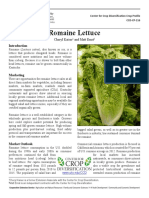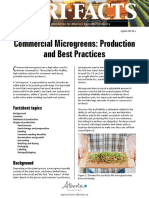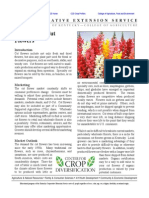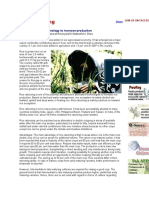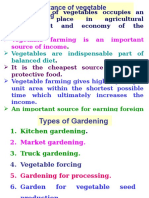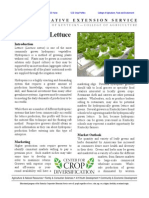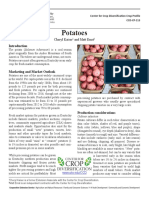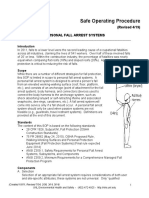0 ratings0% found this document useful (0 votes)
119 viewsGuidelines For Growing Microgreens ECO City Farms
Guidelines For Growing Microgreens ECO City Farms
Uploaded by
BtsibandaThis document provides information on microgreen production. Microgreens are young vegetable and herb seedlings harvested before the first true leaves. They require protected growing conditions like a greenhouse. Many crops can be used but lettuce may be too delicate. Seeds are densely planted and harvested within 7-14 days. Microgreens require careful handling and cooling after harvest due to their perishability. The main market is restaurants, though some farms and markets also sell microgreens.
Copyright:
© All Rights Reserved
Available Formats
Download as PDF, TXT or read online from Scribd
Guidelines For Growing Microgreens ECO City Farms
Guidelines For Growing Microgreens ECO City Farms
Uploaded by
Btsibanda0 ratings0% found this document useful (0 votes)
119 views3 pagesThis document provides information on microgreen production. Microgreens are young vegetable and herb seedlings harvested before the first true leaves. They require protected growing conditions like a greenhouse. Many crops can be used but lettuce may be too delicate. Seeds are densely planted and harvested within 7-14 days. Microgreens require careful handling and cooling after harvest due to their perishability. The main market is restaurants, though some farms and markets also sell microgreens.
Original Description:
Microgreens
Original Title
Guidelines for Growing Microgreens ECO City Farms
Copyright
© © All Rights Reserved
Available Formats
PDF, TXT or read online from Scribd
Share this document
Did you find this document useful?
Is this content inappropriate?
This document provides information on microgreen production. Microgreens are young vegetable and herb seedlings harvested before the first true leaves. They require protected growing conditions like a greenhouse. Many crops can be used but lettuce may be too delicate. Seeds are densely planted and harvested within 7-14 days. Microgreens require careful handling and cooling after harvest due to their perishability. The main market is restaurants, though some farms and markets also sell microgreens.
Copyright:
© All Rights Reserved
Available Formats
Download as PDF, TXT or read online from Scribd
Download as pdf or txt
0 ratings0% found this document useful (0 votes)
119 views3 pagesGuidelines For Growing Microgreens ECO City Farms
Guidelines For Growing Microgreens ECO City Farms
Uploaded by
BtsibandaThis document provides information on microgreen production. Microgreens are young vegetable and herb seedlings harvested before the first true leaves. They require protected growing conditions like a greenhouse. Many crops can be used but lettuce may be too delicate. Seeds are densely planted and harvested within 7-14 days. Microgreens require careful handling and cooling after harvest due to their perishability. The main market is restaurants, though some farms and markets also sell microgreens.
Copyright:
© All Rights Reserved
Available Formats
Download as PDF, TXT or read online from Scribd
Download as pdf or txt
You are on page 1of 3
Center for Crop Diversification Crop Profile
CCD-CP-104
Microgreens
Cheryl Kaiser1 and Matt Ernst2
Introduction
Microgreens are young, tender, edible crops that are
harvested as seedlings. These tiny plants are grown to
the first true leaf stage. They should not be confused
with sprouts, which are germinated seeds lacking true
leaves. Microgreens are sold as a raw product for use
in salads, on sandwiches, and as a garnish.
Microgreens production requires a protected environ-
ment, such as a greenhouse or high tunnel. It is also
possible to produce microgreens indoors under artifi-
cial lights. The short turnaround time and potentially consumers, but the highly perishable nature of the
high value of microgreens can seem attractive to pro- crop can create substantial marketing challenges,
ducers; however, production is very labor-intensive. particularly for inexperienced growers.
Marketing One possible marketing strategy for producers
Although interest in microgreens has expanded since interested in growing microgreens is to work directly
their introduction into high-end culinary establishments with a restaurant or chef, growing and delivering
in the late 1990s, the main market continues to be microgreens at the requests and preferences of the
restaurant chefs. Other direct market opportunities restaurateur. Microgreens are typically purchased and
could include upscale or gourmet grocery stores, as used by restaurants in small amounts, and the quick
well as health food stores. growing and harvest time may make this a more
attractive crop for very small growers interested in
Market Outlook developing nearby, high-end specialty markets for fresh
Microgreens, known in the past as vegetable confetti, produce. Regulations and food safety requirements
increased in popularity after being introduced in haute may evolve and change for newer products like
cuisine around 2006. Many restaurants now routinely microgreens, and growers should check with state
use microgreens as garnishes or flavorings, and or federal agencies for any specific requirements or
consumers are more aware of microgreens as a highly considerations.
nutritious food that can be grown hydroponically.
Microgreens are also offered by some community Production Considerations
supported agriculture farms and year- Crop selection
round farmers market vendors to extend A large number of vegetable, herb and
the produce season. Some specialty agronomic crops and crop varieties can
grocers and health-food stores are be used for microgreen production.
interested in supplying microgreens to www.uky.edu/CCD Lettuces may be too delicate, and are
1
Cheryl Kaiser is a former Extension Associate with the Center for Crop Diversification.
2
Matt Ernst is an independent contractor with the Center for Crop Diversification.
Cooperative Extension Service | Agriculture and Natural Resources | Family and Consumer Sciences | 4-H Youth Development | Community and Economic Development
often not considered good candidates for microgreens. crop are broadcast densely over the media. Treated
Refer to Table 1, below, for a partial listing of potential seeds may have elevated levels of chemical residue in
crops. the small seedlings and are discouraged. The optimum
seed density is one that maximizes production space
Crop selection is often based on seedling color, texture, while avoiding stands so thick that stems become
flavor and market demand. How quickly and easily the elongated and/or disease issues develop. Depending
seed germinates should be another consideration for on the crop and production system, a light layer of
the producer. Growers may need to evaluate a number growing media may be spread over the seeds. It is best
of crops, in consultation with end-user markets, before to seed only one type or cultivar per flat; however, if
selecting the ones most suitable to their production more than one species will be seeded in the same flat,
system and market. the crops should have similar germination rates so the
whole flat can be harvested at the same time. Irrigation
Table 1. Potential Microgreen Crops with overhead mist or an ebb and flow bench system
is common. Well or county water should be used for
Amaranth Fennel irrigation as surface water sources, such as ponds,
Arugula Kale pose a disease and product contamination risk.
Asian greens Kohlrabi
Pest management
Basil Lemongrass
The microgreen high density cropping system provides
Beet Mizuna
the ideal environment for the development of seedling
Broccoli Mustard
diseases. These young tender plants are particularly
Buckwheat Nasturtium
vulnerable to Pythium and Phytophthora damping-
Cabbage Onion off; however, Botrytis, Sclerotinia and Rhizoctonia
Carrot Parsley diseases may pose a problem on some hosts. Sanitation,
Celery Popcorn proper plant density for good air circulation, and good
Chives Radish cultural practices will be necessary to prevent these
Cilantro Spinach diseases from gaining a foothold. In addition, the
Collards Sweet pea use of a sterile soilless media, which is required for
Cress Swiss chard success, should reduce any potential disease problems.
Dill Tatsoi Potential insect problems include aphids and thrips.
Harvest and storage
Production site and planting The time from seed to harvest varies between crop
The delicate nature of microgreens requires that they species; however, many seedlings will be ready
be protected from rainfall and other environmental for harvest in seven to 14 days. Microgreens are
stresses; thus they need to be grown in a greenhouse, harvested at the first true-leaf stage; seedlings will
high tunnel, shade structure or indoors. These crops be approximately 1½ to 2 inches tall. Only the
may be grown in conventional bench-top production stems with leaves attached are harvested; roots are
or hydroponically. Growers should note that fertilizer left behind. Whether grown in a bench-top system
is not needed for fast growing microgreens such as the or hydroponically, stems should be cut high enough
brassicas. Fertilizer may be helpful for slower growing above the growing media to prevent contamination
microgreens such as carrot, lemongrass and onion. of the harvested crop. Plants grown in soilless media
are cut by hand just above the soil line using scissors.
Plastic flats with drainage holes at the bottom are An electric knife or trimmer can be used to harvest
generally used for microgreen production. The trays microgreens grown on seeding mats. Mats are held
are either lined with a sterile fiber-like seeding mat or vertically while the crop is “shaved” from the mat into
partially filled with a peat-based soilless germinating a clean container.
media. Hydroponic producers may utilize aggregate
culture with rockwool as the inert growing medium. Microgreens are highly perishable and need to be
Pesticide-free and highly viable seeds of the desired washed and cooled as soon after harvest as possible.
Food safety good handling Harvest labor for microgreens
practices should be followed. will be greater than leaf let-
Microgreens are packaged tuces grown under shelter due
into plastic clamshell con- to more intensive harvest op-
tainers for grocers. Often the erations.
entire tray is sent intact to
a restaurant where the chef Because of the significant
harvests the microgreens as variations between micro-
needed. However, only those green market prices and pro-
microgreens grown in a rock- duction systems, a producer
wool slab or growing mat (or should estimate potential pro-
something similar) could be duction costs based on their
marketed to restaurants in this individual situation. Produc-
manner since any sort of loose growing media would tion budget templates for lettuce may be modified to
not be permitted in the food preparation area. individual microgreen production situations. Template
budgets for high tunnel and greenhouse production
Labor requirements are listed in the resources, below.
Microgreen production is a highly labor-intensive
endeavor. Labor will be needed for preparing growing Producers able to market high-quality microgreens at
trays, seeding and harvest. Because of the short crop $25 to $50 per pound are likely to generate positive
turnaround and necessity of a continuous succession economic returns from this crop under both high
of plantings, labor needs will also be continuous. tunnel and greenhouse production systems.
Labor requirements will vary considerably between
production scale and systems. Harvest and handling Selected Resources
are the most labor-intensive parts of microgreen • High Tunnel Sample budgets and Spreadsheets
production. (Cornell University)
http://blogs.cornell.edu/hightunnels/economics/
Economic Considerations sample-budgets-spreadsheets/
Initial investments include greenhouse or high tunnel • Hydroponic Crop Program Budgets (Ohio State
construction, installation of an irrigation system, University) http://u.osu.edu/greenhouse/hydroponic-
plus equipment purchases. Additional start-up costs crop-program-economic-budgets/
include purchase of seed, flats, growing media and • Microgreens: A New Specialty Crop (University of
other inputs. Seed purchase costs may be significant Florida, 2016) http://edis.ifas.ufl.edu/hs1164
for this enterprise.
Suggested Citation:
Establishment costs for high tunnels and greenhouses Kaiser, C. and M. Ernst. (2018). Microgreens. CCD-CP-104.
Lexington, KY: Center for Crop Diversification, University
can greatly vary and may be especially impacted by of Kentucky College of Agriculture, Food and Environment.
site preparation and equipment purchases. Establishing Available: http://www.uky.edu/ccd/sites/www.uky.edu.ccd/files/
a high tunnel can cost around $1.50 per square foot, microgreens.pdf
plus labor costs. Greenhouse establishment can range
from $8 to $30 per square foot.
Reviewed by Rick Durham, UK Extension Specialist, and Shari Dutton, UK Horticulturalist
Photos courtesy of USDA May 2018
For additional information, contact your local County Extension agent
Educational programs of Kentucky Cooperative Extension serve all people regardless of economic or social status and will not discriminate on the basis of race, color, ethnic origin, national origin, creed, religion, political
belief, sex, sexual orientation, gender identity, gender expression, pregnancy, marital status, genetic information, age, veteran status, or physical or mental disability.
You might also like
- Hydroponic Lettuce: Cheryl Kaiser and Matt ErnstDocument4 pagesHydroponic Lettuce: Cheryl Kaiser and Matt ErnstKamal deep100% (1)
- Reported Speech: Intermediate LevelDocument14 pagesReported Speech: Intermediate Levelmawatataru100% (1)
- Micro GreensDocument3 pagesMicro GreensCarl RodríguezNo ratings yet
- Microgreens: Cheryl Kaiser and Matt ErnstDocument3 pagesMicrogreens: Cheryl Kaiser and Matt Ernstghonamy100% (1)
- Micro GreensDocument3 pagesMicro GreensHeemanshu Shah0% (1)
- HeirloomDocument4 pagesHeirloomImpasto PhospheratoNo ratings yet
- Hydroponic Lettuce: Cheryl Kaiser and Matt ErnstDocument4 pagesHydroponic Lettuce: Cheryl Kaiser and Matt ErnstmarioNo ratings yet
- Organic Blackberries & RaspberriesDocument5 pagesOrganic Blackberries & Raspberriesmjazic4108No ratings yet
- Ojsadmin, 09 Microgreens An UltimateDocument3 pagesOjsadmin, 09 Microgreens An UltimateAathi RajNo ratings yet
- Grain Amaranth: Cruentus Is Grown To A Lesser ExtentDocument3 pagesGrain Amaranth: Cruentus Is Grown To A Lesser Extentpi_yoanaNo ratings yet
- Lettuce RomaineDocument4 pagesLettuce RomaineDIMITRIS TSOUNo ratings yet
- WatermelonDocument4 pagesWatermelon19aqilatalitahufaidaNo ratings yet
- Herbs Culinary 101Document3 pagesHerbs Culinary 101Altiel MaltielNo ratings yet
- MalabarDocument3 pagesMalabarAena RabonzaNo ratings yet
- Corn Production ManagementDocument19 pagesCorn Production ManagementGelly Anne DomingoNo ratings yet
- Microgreens Production BasicDocument5 pagesMicrogreens Production BasicsonNo ratings yet
- Urban GardeningDocument28 pagesUrban GardeningENANO Jayryl D.No ratings yet
- White Corn Production Guidelines: Drying and StorageDocument2 pagesWhite Corn Production Guidelines: Drying and StorageMay an CarbonelNo ratings yet
- Field Nursery Production: Cheryl Kaiser and Matt ErnstDocument5 pagesField Nursery Production: Cheryl Kaiser and Matt ErnstMeroveokingNo ratings yet
- CRSC101 Preparation of A Micro-GreenBox and Breakfast Buffet Bussiness PlanDocument19 pagesCRSC101 Preparation of A Micro-GreenBox and Breakfast Buffet Bussiness PlanbgcuiNo ratings yet
- Cut FlowersDocument3 pagesCut FlowersZsolt LőrinczyNo ratings yet
- Q2 Crop Care and MaintenanceDocument2 pagesQ2 Crop Care and MaintenancealtheaquenniefayeronquilloNo ratings yet
- Model Farming: Rice Ratooning: A Technology To Increase ProductionDocument3 pagesModel Farming: Rice Ratooning: A Technology To Increase ProductionJONATHAN CACAYURINNo ratings yet
- Importance of Vegetable Farming: Important Place in Agricultural Development and Economy of The CountryDocument18 pagesImportance of Vegetable Farming: Important Place in Agricultural Development and Economy of The CountryKareen Carlos GerminianoNo ratings yet
- Hydro LettuceDocument4 pagesHydro LettucesatindiaNo ratings yet
- Chickpea ProductionDocument38 pagesChickpea ProductionerdemsecenNo ratings yet
- Culinary Herbs by University of KentuckyDocument4 pagesCulinary Herbs by University of KentuckyAnonymous HXLczq3No ratings yet
- Malina OrganicDocument20 pagesMalina OrganicStefan Bozinoski0% (1)
- Inter & Mono-CroppingDocument15 pagesInter & Mono-CroppingJada Hart100% (1)
- Cucumbers PDF PDFDocument6 pagesCucumbers PDF PDFNandi0% (1)
- Nursery ProjectDocument265 pagesNursery ProjectLAXMINARAYANA ROKKAMNo ratings yet
- ApplesDocument4 pagesApplesjaguarytkmrNo ratings yet
- Grower Guide To Tiny GreensDocument8 pagesGrower Guide To Tiny GreensMatthew James Hoffmann100% (5)
- ARABLE CULTIVATION Cassava ProductionDocument6 pagesARABLE CULTIVATION Cassava Productionojo bamideleNo ratings yet
- Chicory - Final .01302018Document6 pagesChicory - Final .01302018Prabhakara Rao ThanikondaNo ratings yet
- How To Grow Micro GreensDocument3 pagesHow To Grow Micro Greenspwilkers3650% (2)
- Fundamentals of Plant Breeding AGS127 PDFDocument92 pagesFundamentals of Plant Breeding AGS127 PDFNikhil SherawatNo ratings yet
- Micro GreensDocument37 pagesMicro GreensNirosha MediwakaNo ratings yet
- Talong and Sili Production.Document10 pagesTalong and Sili Production.empleogabrielle85No ratings yet
- Potatoes: Cheryl Kaiser and Matt ErnstDocument3 pagesPotatoes: Cheryl Kaiser and Matt ErnstPaulNo ratings yet
- Peter Angelo GDocument7 pagesPeter Angelo GNexon Rey SantisoNo ratings yet
- Thesis About Sweet PepperDocument5 pagesThesis About Sweet Peppersunshineblackburnhayward100% (2)
- Attachment PPTDocument15 pagesAttachment PPTlemmademe204No ratings yet
- Notes 3Document16 pagesNotes 3wwaweru210No ratings yet
- 4th - Ho - Vegetable Seed Production - Abdulqadir-Khdr-BayzDocument14 pages4th - Ho - Vegetable Seed Production - Abdulqadir-Khdr-BayzRebwar OsmanNo ratings yet
- Cantaloupe ProductionDocument6 pagesCantaloupe ProductionmasoudbaranNo ratings yet
- PIVOT POGI Factsheet Intercropping 102816Document8 pagesPIVOT POGI Factsheet Intercropping 102816Chala KelbessaNo ratings yet
- Cultural PracticesDocument3 pagesCultural PracticesrexazarconNo ratings yet
- RT Vol. 9, No. 3 Back To BasicsDocument1 pageRT Vol. 9, No. 3 Back To BasicsRice TodayNo ratings yet
- Arrowroot Farming in Kenya 2024Document5 pagesArrowroot Farming in Kenya 2024bazaqiyaNo ratings yet
- WheatDocument12 pagesWheatRINKU BENIWALNo ratings yet
- Revista El ProductorDocument13 pagesRevista El Productor10262166No ratings yet
- Vegetable Hybrid Seed ProductionDocument12 pagesVegetable Hybrid Seed ProductionZakriya AlviNo ratings yet
- 01 - Objectives of Plant BreedingDocument6 pages01 - Objectives of Plant BreedingVoice AnonymousNo ratings yet
- Peanuts PDFDocument4 pagesPeanuts PDFWahyuningsih HamidNo ratings yet
- Save and Grow: CassavaFrom EverandSave and Grow: CassavaRating: 5 out of 5 stars5/5 (1)
- The Potato - With Information on Varieties, Seed Selection, Cultivation and Diseases of the PotatoFrom EverandThe Potato - With Information on Varieties, Seed Selection, Cultivation and Diseases of the PotatoNo ratings yet
- Sanctuary: New CovenantDocument13 pagesSanctuary: New CovenantBtsibandaNo ratings yet
- Mutara F&VM Ju 2021Document1 pageMutara F&VM Ju 2021BtsibandaNo ratings yet
- Mutara Holdings Pty (LTD) T/A: Statement of Invoices July 2021Document1 pageMutara Holdings Pty (LTD) T/A: Statement of Invoices July 2021BtsibandaNo ratings yet
- Phillip Farm Soil AnalysisDocument10 pagesPhillip Farm Soil AnalysisBtsibandaNo ratings yet
- Caroline Center Upholstery Business PlanDocument37 pagesCaroline Center Upholstery Business PlanBtsibandaNo ratings yet
- Envirobent For Dam Sealing Typical ApplicationsDocument1 pageEnvirobent For Dam Sealing Typical ApplicationsBtsibandaNo ratings yet
- Jesus Loves Me - Anna Warner - 5august2012Document2 pagesJesus Loves Me - Anna Warner - 5august2012BtsibandaNo ratings yet
- Ministry of Healing Test Booklet - SCANDocument152 pagesMinistry of Healing Test Booklet - SCANBtsibandaNo ratings yet
- Old Columbia Pike, Silver Spring, MD 20904Document4 pagesOld Columbia Pike, Silver Spring, MD 20904BtsibandaNo ratings yet
- Envirobent Dam Seal AB50Document1 pageEnvirobent Dam Seal AB50BtsibandaNo ratings yet
- The Microgreens Price List 2021Document1 pageThe Microgreens Price List 2021Btsibanda100% (1)
- 2021-2022-BHP Reading Guide PDFDocument2 pages2021-2022-BHP Reading Guide PDFBtsibandaNo ratings yet
- Envirobent For Dam SealingDocument1 pageEnvirobent For Dam SealingBtsibandaNo ratings yet
- TLC CompPlan DIGITAL 07262019Document15 pagesTLC CompPlan DIGITAL 07262019BtsibandaNo ratings yet
- Leadership: Crisis ofDocument8 pagesLeadership: Crisis ofBtsibandaNo ratings yet
- Involved: An Exciting Way To GetDocument13 pagesInvolved: An Exciting Way To GetBtsibandaNo ratings yet
- SADC Regional Outlook For The 2020 - 2021 SeasonDocument13 pagesSADC Regional Outlook For The 2020 - 2021 SeasonBtsibandaNo ratings yet
- AG Nutrition Business Concept2 PDFDocument34 pagesAG Nutrition Business Concept2 PDFBtsibanda100% (2)
- AG Nutrition GHANA-1-1-1Document23 pagesAG Nutrition GHANA-1-1-1Btsibanda100% (1)
- In Pit, Prison, or PalaceDocument7 pagesIn Pit, Prison, or PalaceBtsibandaNo ratings yet
- Price Adjustment BotswanaDocument1 pagePrice Adjustment BotswanaBtsibandaNo ratings yet
- Ceda New Guidelines - July 2020Document20 pagesCeda New Guidelines - July 2020BtsibandaNo ratings yet
- Group Assignment InstructionsDocument1 pageGroup Assignment InstructionsAdarsh AgarwalNo ratings yet
- PMAY-LIC Housing Finance LimitedDocument6 pagesPMAY-LIC Housing Finance Limitedamir sohailNo ratings yet
- Lesson 2 The Self Society and CultureDocument1 pageLesson 2 The Self Society and CultureShahrooz GolparvarNo ratings yet
- Memoq Productivity Guide2019Document39 pagesMemoq Productivity Guide2019Germano MatiasNo ratings yet
- For Each Period, Calculate The Ratio of Each COQ Category To RevenuesDocument2 pagesFor Each Period, Calculate The Ratio of Each COQ Category To RevenuesElliot RichardNo ratings yet
- RR CableDocument3 pagesRR CableRJ MechNo ratings yet
- QV5721 StudentGuideDocument184 pagesQV5721 StudentGuideMohit Gautam100% (1)
- Capsicum Frustascens Cayenne Pepper Decoction As An Alternative Killer For CockroachesDocument4 pagesCapsicum Frustascens Cayenne Pepper Decoction As An Alternative Killer For CockroachesRhitzelynn Ann BarredoNo ratings yet
- Uber Digital BusinessDocument5 pagesUber Digital BusinessDevansh RaiNo ratings yet
- Safe Operating Procedure: (Revised 4/19) Personal Fall Arrest SystemsDocument7 pagesSafe Operating Procedure: (Revised 4/19) Personal Fall Arrest SystemsUlviyye ElesgerovaNo ratings yet
- Video and Abstract Expressionism: Hermine FreedDocument10 pagesVideo and Abstract Expressionism: Hermine Freeddonkey slapNo ratings yet
- Welcome To The World of Aditya Birla Capital!: Mobile NoDocument39 pagesWelcome To The World of Aditya Birla Capital!: Mobile Nom00162372No ratings yet
- Graficos Z Score OMS Ariane Inacio CordeiroDocument12 pagesGraficos Z Score OMS Ariane Inacio CordeiroArianeNo ratings yet
- Real Estate EconomicsDocument8 pagesReal Estate Economicsbea100% (3)
- Tianjin Zhongwang ProfileDocument42 pagesTianjin Zhongwang ProfileRaul CochranNo ratings yet
- Champions League 2024 ScheduleDocument1 pageChampions League 2024 Scheduleapi-499214664No ratings yet
- History of FirefightingDocument10 pagesHistory of FirefightingDhelia GermanNo ratings yet
- Multiliteracy Lesson PlanDocument6 pagesMultiliteracy Lesson Planapi-346065104No ratings yet
- Case Study: JaspersoftDocument3 pagesCase Study: Jaspersofteduluz1976No ratings yet
- Catering Alfabet NewDocument4 pagesCatering Alfabet NewCynthia SetiawanSNo ratings yet
- UNHINGEDDocument2 pagesUNHINGEDjoycadiz09No ratings yet
- Price Guide: For Our New Mobile Broadband PlansDocument18 pagesPrice Guide: For Our New Mobile Broadband PlansYukimora NagatoNo ratings yet
- Nutrition and Feeding of Sheep and GoatsDocument57 pagesNutrition and Feeding of Sheep and GoatsHaolitNo ratings yet
- MHM1523-Ind Assignment-Estee Lauder Companies, Inc-Wong Yean Chong-1Document26 pagesMHM1523-Ind Assignment-Estee Lauder Companies, Inc-Wong Yean Chong-1wisely100% (1)
- Classical Quarterly - 'Conscription of Hoplites in Classical Athens' by Matthew R. Christ, 2001Document26 pagesClassical Quarterly - 'Conscription of Hoplites in Classical Athens' by Matthew R. Christ, 2001pbas121No ratings yet
- Morphological Variation, Population Genetics and Genetric Relatedness in Three Species of CalloporaDocument330 pagesMorphological Variation, Population Genetics and Genetric Relatedness in Three Species of Calloporathanos roussosNo ratings yet
- List Components 50 DefinitionDocument2 pagesList Components 50 DefinitionaNo ratings yet
- Empowering Women Through MicrofinanceDocument14 pagesEmpowering Women Through MicrofinanceBhumika MahatoNo ratings yet
- 78 03 OfftoaRockyStart US StudentDocument4 pages78 03 OfftoaRockyStart US StudentDAVENo ratings yet










